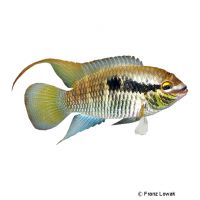Yellow Lip Laetacara (Laetacara flavilabris)
| Yellow Lip Laetacara Laetacara flavilabris | |
|---|---|
| Name | Yellow Lip Laetacara |
| Name Lat. | Laetacara flavilabris |
| Synonym | Aequidens flavilabris |
| Family | Cichlids |
| Family lat. | Cichlidae |
| Order | Cichlids |
| Order lat. | Cichliformes |
| Origin | Ecuador, Peru, Brazil |
| Habitat | Forest streams, ponds |
| Diet | Carnivore |
| pH | 5.5-7.0 |
| Behavior | Peaceful |
| Keeping | Pair |
| Care Level | Moderate |
| Reproduction | Substrate spawner |
| Breeding | Moderately difficult |
| Life Span | 3-5 years |
| Protection | No |
| Metric Units | |
| Size | 7-9 cm |
| Temperature | 20-26 °C |
| Hardness | 1-10 °dH |
| Aquarium | ~ 150 l |
| US Units | |
| Size | 2.8"-3.5" |
| Temperature | 68-79 °F |
| Hardness | 18-178 ppm |
| Aquarium | ~ 40 gal |
Distribution and habitat
The Flavilabris spotted cichlids are widespread in Brazil (Rio Solimoes, Rio Jurua), in Ecuador (Rio Napo, Rio Ptutumayo) and in Peru (Rio Yavari) as well as in the catchment area of the lower Amazon in Brazil. They live in the still water of shallow, slow-flowing jungle streams and in residual water pools.
Maintenance
The aquarium should have a dense border planting, with many hiding places (stones, roots) and offer free swimming space. A dark substrate of sand or fine gravel covered with some foliage (e.g. sea almond leaves) and subdued light (floating plants) is ideal. Some flat stones, which serve as spawning ground, should not be missing.
No ammonia, ammonium and nitrite should be detectable, the nitrate value should not exceed 100 mg/l. To ensure the water quality and oxygen content, a filter and heater adapted to the aquarium size is required, as well as lighting for the species-appropriate day-night rhythm of the animals.
Diet
In nature they feed mainly on insects, insect larvae, small crustaceans and plankton. The food supply consists of live, frozen and dry food. For a balanced diet, feed once a day with a high-quality dry food for cichlids (flakes, granules, pellets) as well as cyclops, daphnia, artemia, mosquito larvae, etc. (live or frozen)
It is recommended to feed small portions several times a day. Only feed as much as will be eaten within a few minutes. A regular and varied diet promotes health and prevents deficiency symptoms.
Behaviour and compatibility
These peaceful cichlids should be kept in pairs. At spawning time they consistently defend their territory. Keeping several pairs is only recommended in a larger and richly structured tank. They can be socialized well with other peaceful fish
Basically, only compatible fish species with similar demands on water quality and water temperature may be socialized.
Sex dimorphism
The sexes are difficult to distinguish. The male is larger and has noticeably longer, more pointed fins, the female appears somewhat rounder.
Reproduction and breeding
They spawn on shallow stones or roots (open brooders). Both parents perform brood care and defend the territory (parental family). After 48 hours, the fry hatch and are then usually housed in a bottom pit until they swim freely after 5-7 days. Often the young fish swarm is still protected by the parents for some time and also led to the feeding places in the aquarium.
Fry must be fed several times a day with special rearing food (Artemia nauplii). In community tanks breeding is hardly possible, because the fry are easy prey.
Important
There are populations that differ in coloration (site variants)
The foliage (sea almond tree, oak, etc.) enriches the water with humic substances, naturally lowers the pH and is a valuable secondary food source.
The well-being of the fish should be monitored regularly. Temperature should be checked daily, pH, hardness and nitrate levels should be checked at least every 14 days. Regular partial water changes are recommended, even when contaminant levels have not yet reached the upper limit. Sudden changes in water quality should be avoided. Newly introduced fish must be accustomed slowly to the water in the aquarium.
Further literature can be found in your pet store.
References
Text: Werner Winter; Image: Franz Lowak
Source: BMELV (1998): Tierschutzgutachten - Haltung von Zierfischen (Süßwasser); RIEHL & BAENSCH (2006): Aquarien Atlas Bd. 1, Mergus Verlag; ENGELMANN (2005): Zootierhaltung - Tiere in menschlicher Obhut: Fische, Verlag Harri Deutsch
- Gemäß § 21 Abs. 5 Tierschutzgesetz idgF
